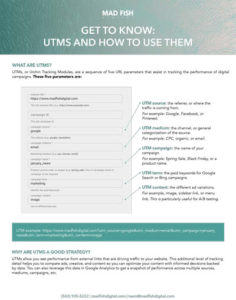After conducting research, developing a strategy, collaborating with experts, and finally launching a digital marketing campaign, many marketers find themselves unsure of the best way to track its success. And, beyond success or failure, many don’t know how to measure its effectiveness—what worked, what didn’t work, and how to iterate for the next campaign. Luckily, there’s a simple solution that is key for measuring digital marketing campaigns: UTMs.
Read on to learn more about what UTMs are, when to use them, and how to start leveraging them for your next digital marketing campaign.
What are UTMs?
UTMs, or Urchin Tracking Modules, are a sequence of five URL parameters that assist in tracking the performance of digital campaigns. These five parameters are defined as follows:
- UTM source—the referrer, or where the traffic is coming from. For example: Google, Facebook, or Pinterest.
- UTM medium—the channel, or general categorization of the source. For example: CPC, organic, or email.
- UTM campaign—the name of your campaign. For example: Spring Sale, Black Friday, or a product name.
- UTM term—the paid keywords for Google Search or Bing campaigns.
- UTM content—the different ad variations. For example, image, sidebar link, or menu link. This is particularly useful for A/B testing.
When to Use UTMs for Measuring Digital Marketing Campaigns
Any digital marketing campaign, including paid, email, organic social, blogs, and A/B tests, can leverage UTMs. UTMs allow you to compare ads, creative, and content so you can make informed decisions backed by data. For example, you could leverage a UTM term to A/B test creative or copy variations and compare their performance. Or, if you’re posting a new blog on your social channels, you can gauge which channel drives the most traffic by adding UTMs and then comparing the channels in Google Analytics using the source/medium report.
How to Create a UTM
UTMs can be created through platform resources like Google Developers UTM builder or by leveraging in-platform UTM builders like Google or Facebook Ads Manager. Each of the five main parameters can be used or left out, depending on your UTM strategy. For instance, if you’re only concerned with source and medium, you can use those two parameters only. If you prefer to manually edit URLs, you can do so by adding “/?utm_source=SOURCE&utm_medium=MEDIUM.” All of these are options when creating or adding UTMs to your campaigns.
How to Report on UTMs
Google Analytics is a great platform for analyzing the performance of UTMs. In Google Analytics, you can leverage specific reports based on UTM parameters. A common UTM report is the source/medium report, allowing you to compare marketing efforts across platforms in one unified location. Additionally, you can add parameters to further drill down into reporting. With this singular snapshot, you can save time reporting and assess performance to shift resources or make meaningful decisions in your marketing strategies.
Download our PDF to learn more about UTMs and how to use them.
Your Paid Media Agency for Digital Marketing Campaigns
If you’re still not sure where to start with UTMs, get in touch. We have a team of paid media experts who will ensure your digital campaigns—whether social media, email marketing, or paid advertising—are optimized and measured successfully.



